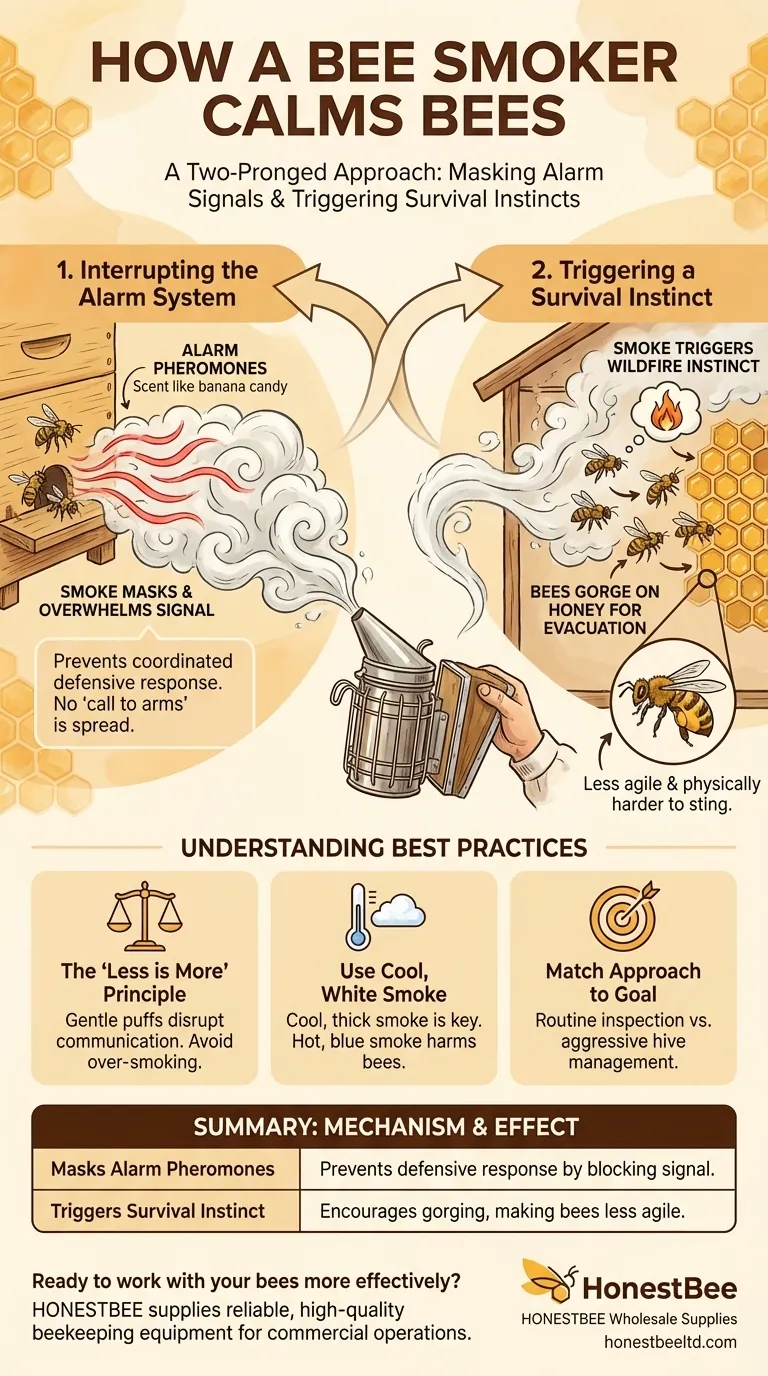To put it simply, a bee smoker calms bees using a two-pronged approach. The smoke masks the bees' primary "alarm" pheromones, preventing the colony from mounting a coordinated defensive response. It also triggers a deep-seated survival instinct that makes them believe their hive is threatened by fire, causing them to focus on eating honey rather than attacking.
A bee smoker doesn't sedate bees; it cleverly exploits their natural communication and survival behaviors. By interrupting their alarm signals and initiating a false fire drill, it redirects their energy from defense to self-preservation.

Deconstructing the Bee's Response to Smoke
To understand how a smoker works, you must first understand the two primary ways it influences bee behavior. It's both a chemical interruption and a psychological trigger.
Interrupting the Alarm System
Guard bees release an alarm pheromone when they perceive a threat. This chemical signal instantly alerts the rest of the colony to a potential danger, preparing them to attack.
This pheromone is said to smell like banana candy to humans. The thick smoke from a smoker effectively masks or overwhelms this signal, preventing it from spreading throughout the hive. Without the chemical "call to arms," a large-scale defensive reaction is never initiated.
Triggering a Survival Instinct
The presence of smoke triggers a primal instinct in bees related to wildfires. They associate smoke with the potential destruction of their home.
In response, their top priority shifts from defending the hive to preparing for a potential evacuation. They begin to gorge themselves on honey, stocking up on energy reserves in case they need to abandon the hive and find a new location.
A bee with a full abdomen of honey is physically less able to flex its body to sting. This combination of distraction and physical impediment makes the bees significantly more docile and manageable.
Understanding the Trade-offs and Best Practices
While a smoker is an indispensable tool, its effectiveness depends entirely on correct usage. Misuse can be counterproductive and even harmful.
The "Less is More" Principle
The goal is to introduce just enough smoke to disrupt communication, not to overwhelm the hive. A few gentle puffs at the hive entrance and a few more under the lid are often all that is needed.
Over-smoking can irritate the bees, cause them to become agitated, and potentially harm their respiratory systems. It can also impact the beekeeper's own health.
Use Cool, White Smoke
The ideal output from a smoker is cool, white, and thick smoke. Hot, blueish smoke indicates the fuel is burning too quickly and can harm or anger the bees.
Properly packed fuel that smolders slowly is the key to producing the right kind of smoke for gentle and effective colony management.
Making the Right Choice for Your Goal
Using a smoker is about communicating with the hive, not subduing it. Your approach should match your objective.
- If your primary focus is a routine inspection: Use a few gentle puffs at the entrance 1-2 minutes before opening the hive to calmly announce your presence.
- If your primary focus is managing a known aggressive hive: Use slightly more smoke to ensure alarm pheromones are fully masked, giving you the time needed to work safely.
- If your primary focus is minimizing stress on the colony: Always opt for moderation, ensuring your smoke is cool and applying it only when the bees begin to show signs of agitation.
Ultimately, a bee smoker is a tool that allows you to work in harmony with the bees' natural instincts.
Summary Table:
| Mechanism | Effect on Bees |
|---|---|
| Masks Alarm Pheromones | Prevents coordinated defensive response by blocking the 'call to arms' signal. |
| Triggers Survival Instinct | Encourages bees to gorge on honey, making them less agile and less likely to sting. |
Ready to work with your bees more effectively?
A bee smoker is just one essential tool for successful hive management. For commercial apiaries and distributors, having access to reliable, high-quality beekeeping supplies is critical for safety and productivity.
HONESTBEE supplies the durable equipment you need, from smokers and protective gear to hive components, through our wholesale-focused operations. Let us help you equip your operation for success.
Contact HONESTBEE today to discuss your supply needs and get a quote.
Visual Guide

Related Products
- European Stainless Steel Bee Smoker for Honey Bee Hive
- Stainless Steel Honey Bee Smoker Hive and Honeycomb Smoker for Beekeeping
- Economy Galvanized Beekeeping Honey Bee Smoker for Wholesale
- Electric Bee Smoker European Style Bee Hive Smoker for Beekeeping
- Premium Traditional Copper Bee Smoker with Bellows
People Also Ask
- What are the advantages of a high-quality bee smoker? Achieve Calm, Confident Hive Management
- What factors should be considered when choosing a bee smoker? Find the Right Tool for Safe, Effective Hive Management
- What are the differences between stainless steel and galvanized steel bee smokers? Choose the Right Smoker for Your Apiary
- What are the features of a recommended bee smoker? A Guide to Safety, Durability & Performance
- What are the benefits of cleaning a bee smoker? Ensure Hive Safety and Bee Health



















